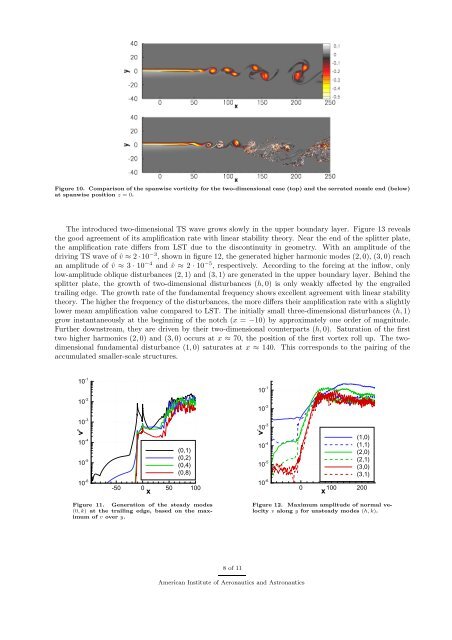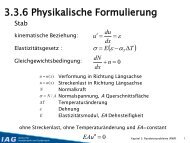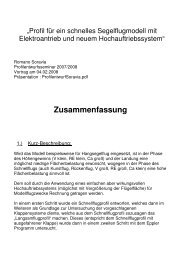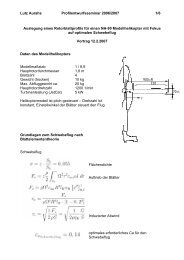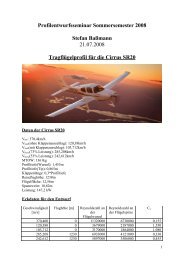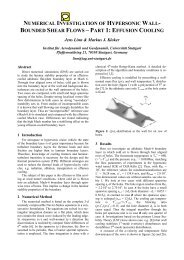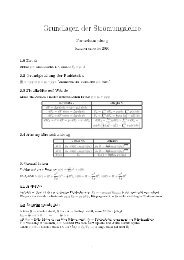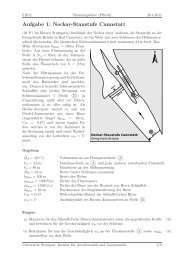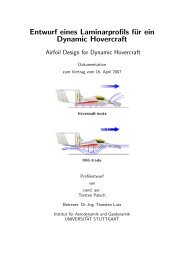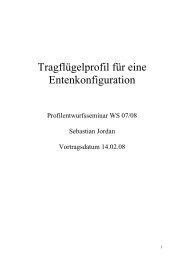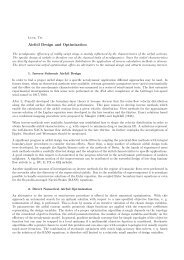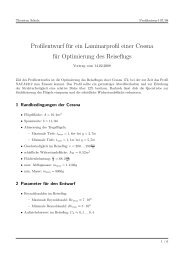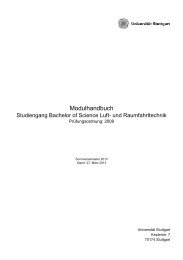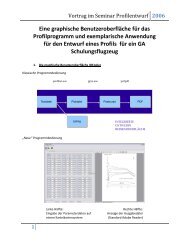pdf-File - IAG - Universität Stuttgart
pdf-File - IAG - Universität Stuttgart
pdf-File - IAG - Universität Stuttgart
Create successful ePaper yourself
Turn your PDF publications into a flip-book with our unique Google optimized e-Paper software.
Figure 10. Comparison of the spanwise vorticity for the two-dimensional case (top) and the serrated nozzle end (below)<br />
at spanwise position z = 0.<br />
The introduced two-dimensional TS wave grows slowly in the upper boundary layer. Figure 13 reveals<br />
the good agreement of its amplification rate with linear stability theory. Near the end of the splitter plate,<br />
the amplification rate differs from LST due to the discontinuity in geometry. With an amplitude of the<br />
driving TS wave of ˆv ≈ 2 · 10 −3 , shown in figure 12, the generated higher harmonic modes (2, 0), (3, 0) reach<br />
an amplitude of ˆv ≈ 3 · 10 −4 and ˆv ≈ 2 · 10 −5 , respectively. According to the forcing at the inflow, only<br />
low-amplitude oblique disturbances (2, 1) and (3, 1) are generated in the upper boundary layer. Behind the<br />
splitter plate, the growth of two-dimensional disturbances (h, 0) is only weakly affected by the engrailed<br />
trailing edge. The growth rate of the fundamental frequency shows excellent agreement with linear stability<br />
theory. The higher the frequency of the disturbances, the more differs their amplification rate with a slightly<br />
lower mean amplification value compared to LST. The initially small three-dimensional disturbances (h, 1)<br />
grow instantaneously at the beginning of the notch (x = −10) by approximately one order of magnitude.<br />
Further downstream, they are driven by their two-dimensional counterparts (h, 0). Saturation of the first<br />
two higher harmonics (2, 0) and (3, 0) occurs at x ≈ 70, the position of the first vortex roll up. The twodimensional<br />
fundamental disturbance (1, 0) saturates at x ≈ 140. This corresponds to the pairing of the<br />
accumulated smaller-scale structures.<br />
10 -2<br />
10 -2<br />
10 -3<br />
v’<br />
10 -1 (0,1)<br />
10 -3<br />
v’<br />
10 -1 (1,0)<br />
10 -4<br />
10 -5<br />
10 -6<br />
-50 0 50 100<br />
x<br />
(0,2)<br />
(0,4)<br />
(0,8)<br />
10 -4<br />
10 -5<br />
10 -6<br />
0 100 200<br />
x<br />
(1,1)<br />
(2,0)<br />
(2,1)<br />
(3,0)<br />
(3,1)<br />
Figure 11. Generation of the steady modes<br />
(0, k) at the trailing edge, based on the maximum<br />
of v over y.<br />
Figure 12. Maximum amplitude of normal velocity<br />
v along y for unsteady modes (h, k).<br />
8 of 11<br />
American Institute of Aeronautics and Astronautics


